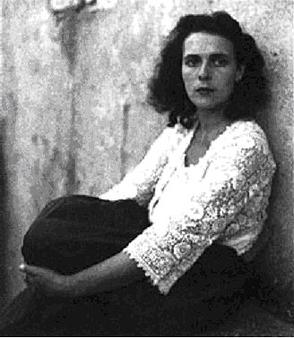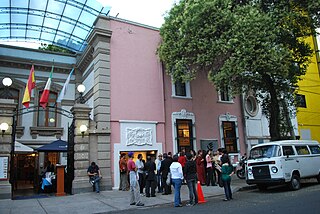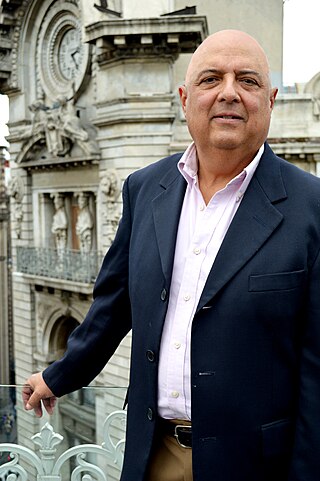Related Research Articles

Isamu Noguchi was an American artist, furniture designer and landscape architect whose artistic career spanned six decades, from the 1920s onward. Known for his sculpture and public artworks, Noguchi also designed stage sets for various Martha Graham productions, and several mass-produced lamps and furniture pieces, some of which are still manufactured and sold.

Lawrence Charles Weiner was an American conceptual artist. He was one of the central figures in the formation of conceptual art in the 1960s. His work often took the form of typographic texts, a form of word art.

Louis Henri Jean Charlot was a French-born American painter and illustrator, active mainly in Mexico and the United States.

Mary Leonora Carrington was a British-born, naturalized Mexican surrealist painter and novelist. She lived most of her adult life in Mexico City and was one of the last surviving participants in the surrealist movement of the 1930s. Carrington was also a founding member of the women's liberation movement in Mexico during the 1970s.

An artist-run space or artist-run centre (Canada) is a gallery or other facility operated or directed by artists, frequently circumventing the structures of public art centers, museums, or commercial galleries and allowing for a more experimental program. An artist-run initiative (ARI) is any project run by artists, including sound or visual artists, to present their and others' projects. They might approximate a traditional art gallery space in appearance or function, or they may take a markedly different approach, limited only by the artist's understanding of the term. "Artist-run initiatives" is an umbrella name for many types of artist-generated activity.
Rubén Ortiz Torres is a Mexican photographer, painter, sculptor, film and video producer.

Abraham Cruzvillegas is a Mexican visual artist. He is best known for his work with found objects, and particularly his ongoing "autoconstrucción" project.

Rosalyn Drexler is an American visual artist, novelist, Obie Award-winning playwright, and Emmy Award-winning screenwriter, and former professional wrestler. Although she has had a polymathic career, Drexler is perhaps best known for her pop art paintings and as the author of the novelization of the film Rocky, under the pseudonym Julia Sorel. Drexler currently lives and works in New York City, New York.

James Luna was a Puyukitchum, Ipai, and Mexican-American performance artist, photographer and multimedia installation artist. His work is best known for challenging the ways in which conventional museum exhibitions depict Native Americans. With recurring themes of multiculturalism, alcoholism, and colonialism, his work was often comedic and theatrical in nature. In 2017 he was awarded a Guggenheim Fellowship.

Salón de la Plástica Mexicana is an institution dedicated to the promotion of Mexican contemporary art. It was established in 1949 to expand the Mexican art market. Its first location was in historic center of the city but today it mostly operates out of a building in Colonia Roma. The institution is run by a membership of almost four hundred recognized artists and holds multiple exhibitions each year. Although it operates autonomously, it is part of the Instituto Nacional de Bellas Artes y Literatura.
Amador Lugo Guadarrama was a Mexican painter, graphic artist, writer and cultural promoter, best known for his landscape painting and the founding of several cultural institutions. He began painting when still a child, attending the Escuela al Aire Libre de Pintura in Taxco then developing his career in Mexico City. At that time, the Mexican muralism school was still dominant. Lugo related to its aesthetics but not so much to its politics, so he participated in the founding of various institutions such as the Sociedad Mexicana de Grabadores and the Salón de la Plástica Mexicana which provided opportunities for artists outside the dominant movement. He also worked as an educator, writer and cultural promoter, mostly in Mexico City and his home state of Guerrero.

Alexandra Grant is an American visual artist who examines language and written texts through painting, drawing, sculpture, video, and other media. She uses language and exchanges with writers as a source for much of that work. Grant examines the process of writing and ideas based in linguistic theory as it connects to art and creates visual images inspired by text and collaborative group installations based on that process. She is based in Los Angeles.

Pablo Kubli is a Mexican sculptor specializing in metals, a member of Mexico’s Salón de la Plástica Mexicana. He initially trained in law and public administration in college, completing bachelor’s and master’s in visual arts later in life. He has one doctorate from the Universidad Politecnica de Valencia, Spain. He's been exhibiting individually since 1991, with most of his works consisting of steel plates and other pieces assembled with nuts and bolts with both organic and geometric forms.
Zalathiel Vargas is a Mexican artist best known for his work in underground comix and illustrations. His work follows a number of the characteristics of comix including explicit sexuality and psychedelic imagery, but is distinguished by influence from Mexican “photo-novels” and strong social and political messages. His work has been exhibited in Mexico and abroad in venues such as the Palacio de Bellas Artes and the Museo de Arte Moderno as well as a retrospective at the Museo Universitario del Chopo of the Universidad Nacional Autónoma de México.

Pablo Helguera is an artist, performer, author, and educator. From 2007 to 2020 he was director of adult and academic programs at the Museum of Modern Art in New York City. He currently is an assistant professor at the college of performing arts at the New School.

Adeline de Monseignat is a Dutch-Monegasque contemporary visual artist who lives and works between London and Mexico City. Made from natural materials such as recycled fur, soil, textiles, glass and marble, her sculptures and installations show an interest in mythology, anthropology and psychology, especially the Uncanny.
Margarita Cabrera is a Mexican-American artist and activist. As an artist, the objects and activities she produces address issues related to border relations, labor practices and immigration. Her practice spans smaller textile-based soft sculptures to large community-involved public artworks. In 2012 she was a recipient of the Knight Artist in Residence at the McColl Center for Visual Art in Charlotte, North Carolina. Cabrera was also a recipient of the Joan Mitchell Foundation Grant.

Claudia Alvarez is a Mexican American painter and sculptor who has worked as an artist in residence in Mexico, Switzerland, France, and China. Alvarez's solo exhibitions include Claudia Álvarez: A Moment in Between at the Acércate at the National Arts Centre, Mexico City; Girls with Guns, Scott White Contemporary Art, La Jolla, California; Falling, Museum of Nebraska Art, Kearney, Nebraska; Silence Water, Museum of Art Contemporary Yucatán, Mérida; American Heroes, Blue Leaf Gallery, Dublin; Things of a Child, The Latino Museum, Omaha, Nebraska; and History of Immigration, Metropolitan Community College, Omaha, Nebraska. Alvarez is based in New York City.
Gambia Castle was an artist-run gallery in Auckland, New Zealand between 2007 and 2010.

Yoshua Okón is a Mexican artist whose work is part of major art collections throughout the world. He is co-founder of La Panadería, an art space that operated between 1994 and 2002, and of SOMA, a contemporary art school. Mexican art critic Cuauhtémoc Medina points out that Okón burst onto the Mexican art scene as a child prodigy. At age twenty-seven he produced works that promptly gained iconic value such as “A propósito” (1997), a sculpture made with 120 stolen car stereos obtained on the black market accompanied by a video in which Okón and Miguel Calderón steal a car stereo, and “Chocorrol” (1997). a visual registry of copulation between a xoloiztcuintle dog and a French poodle. Okón’s work blends staged situations, documentation and improvisation, and questions habitual perceptions of reality and truth, selfhood and morality.
References
- ↑ "Art in Embassies". www.art.state.gov. U.S. Department of State. Archived from the original on 19 October 2014. Retrieved 16 September 2014.
- ↑ "Mexico City: An Exhibition about the Exchange Rates of Bodies and Values". momaps1.org. MOMA PS1. Retrieved 16 September 2014.
- ↑ Cotter, Holland (2 August 2002). "Art in Review". The New York Times . Retrieved 16 September 2014.
- ↑ Gallo, Ruben (2006). New Tendencies in Mexican Art the 1990s (1st ed.). New York: Palgrave Macmillan. p. 7. ISBN 9781403982650.
- ↑ "SOMA-México".